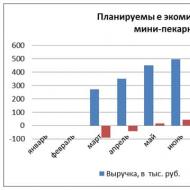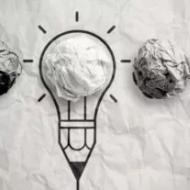
What is b2g. Selecting a sales model. What are combinations of B2B, B2C, B2G How do “businesses” buy and how do “consumers” buy?
Running a successful business is impossible without following the right development strategy. One of the most important elements is knowledge of marketing, the features of sales in business markets of various types. After all, each of them operates on its own terms and requires a special approach in terms of organizing and marketing products, motivating the consumer, and choosing the type of communication.
B2C - what is it?
B2C (from the English “business-to-consumer” - “business for the consumer”) is one of the types of business market in the classification system according to the type of end consumer. Here he is an individual, that is, a retail buyer of a finished product (for example, individual consumers, households), and the seller is a company or organization. Purchasing motivation is emotional and rational in nature; the key factor is a person’s desire to buy a certain product, guided by a subjective assessment and the emotions that arise. The intensity of this process is usually very high. The “bi to si” sales channel can be:
- online store;
- aggregator companies (Avito, Wikimart, Yandex.Market, etc.);
- social media.
But to organize successful sales in the B2C format, it is simply necessary to correctly familiarize the end consumer with the product. This cannot be done without significant financial investments (payment for clicking on a link from an aggregator to a store’s website, promoting your trading platform), and often manufacturers, unlike intermediary companies, simply do not have enough time for quality marketing.
B2B - what is it?
The term B2B is used to designate one of the types of business markets - “business-to-business”, or “business to business”. This model is considered the most convenient for marketing the products of a manufacturing company. The subjects of trading operations are legal entities that sell to each other. In the B2B sales process, the buyer's choice is based on rational considerations, and not on personal emotions, as in the case of B2C work.
To ensure a successful result of activities in this format, the manufacturer must not only create a more favorable price for products and services for the consumer, but satisfy the needs of a specific market or its segment, make sure that the decisive purchasing factor always acts and motivates the buyer. The end consumers in the B2B market are enterprises and private organizations. The key factors of their motivation are the need to solve the company’s tasks and the manager’s desire to receive a reward for the successful implementation of the project.
In addition, in the field of business sales, the manufacturer does not have to create its own logistics, package goods individually, or actively engage in marketing. There is an opportunity to earn money thanks to contract manufacturing, not to produce finished goods, but to produce parts, components and sell them to other companies that will complete the production cycle.
E-commerce systems are successfully developing in the B2B segment. Example: popular web showcases (selling goods and services to companies), B2B communities (creating trading platforms for different suppliers to establish sales) or auctions (exchange of competitive offers between suppliers and buyers), electronic vertical markets (forming a special trading community), etc. .d. You can find buyers on specialized platforms, for example, Alibaba, B2B Center, Pulscen, etc.
B2G - what is it?
B2G (“business to government”) is a term that refers to the commercial relationship between a manufacturer and government organizations as end consumers. In this model of interaction between participants in the business environment, sales are carried out to solve the problems of the enterprise due to the employee’s desire to receive compensation for the work done. Activity ensures cooperation between business and government and administrative structures (from local authorities to international organizations).
The decisive factor for purchasing in such a market is compliance with the characteristics of the product desired by the consumer, legal norms and the minimum price. The characteristics of this sector differ significantly from those of B2B and B2C. First of all, the procurement process is strictly regulated by law - Federal Law No. 94-FZ of July 21, 2005 “On placing orders for the supply of goods, performance of work, provision of services for state and municipal needs”, Federal Law of the Russian Federation of July 18, 2011 No. 223- Federal Law “On the procurement of goods, works, services by certain types of legal entities.” Purchases in this market, as a rule, are always systematic and carried out from one supplier. Customers are state-owned enterprises with a strong production structure, research, scientific and technical organizations, private enterprises that need to update production, large contractors, manufacturing enterprises, as well as intermediaries (Russian or branches of foreign organizations).
All budgetary organizations (hospitals, schools, etc.) participate in the public procurement system, so it is profitable to engage in this type of sales, but it is necessary to understand the specifics of the work. First of all, it is important to ensure that the work format complies with legal norms - the seller depends on the form of cooperation offered by the customer (electronic auction, competition, request for proposals or quotes) and can only accept the proposal and not make changes. You won't be able to actively promote your products. Also, the manufacturer must secure a contract, that is, deposit and freeze a certain amount. Many small and medium-sized enterprises, despite state quotas, are unable to fulfill this condition.
Reading time: 8 minutes. Views 679 Published 05/14/2018
The term “market relations” can be characterized as a transaction between two parties, the purpose of which is the sale and acquisition of marketable products. There are three main markets: B2B, B2G and B2C. The main difference between these markets is the type of buyer. In this article, we propose to consider what B2C is and highlight the key features of this segment.
The term “b2c” comes from the English business to consumer (literally, “business for the consumer”)
Types of markets
Before considering a specific market segment, it is necessary to provide a generalized brief description. The main market segment is considered B2B. This abbreviation comes from the English language and stands for Business to business. This means that various organizations act as sellers and buyers and purchase goods in bulk. Such goods can be used as consumables or industrial raw materials. In some cases, organizations purchase goods for the purpose of further sale in smaller quantities.
The B2G segment is one of the components of the B2B market. The difference between these segments is that government organizations and budget organizations act as buyers.
Here transactions are concluded for the purchase of large quantities of goods that will be used to satisfy the needs of the buyer. Sales are carried out through competitive bidding. In order to take part in the competition, an organization engaged in the production of commercial products must submit an application. B2C is a separate market segment where ordinary consumers act as buyers.
This segment presents various products aimed at meeting the needs of citizens of a particular country. The B2C market is very diverse.
Features of the segment As statistics show, the segment in question has the highest number of consumers. The size of the Moscow consumer market is more than twelve million buyers. This number is equal to the total population of the capital. It is important to note that not every consumer is a direct client.
For a clear example, we should consider small firms involved in the sale of dairy products. The clients of such retail chains can be completely different people. But there are a number of citizens who do not buy these products. This group includes those people who suffer from lactose intolerance.
There are many different factors that negatively affect sales volumes. One of these factors is that the consumer market involves retail. Not every person buys milk every day and in large quantities. Another negative factor influencing the decline in sales is high competition.
The retail market has a fairly low barrier to entry, which encourages the emergence of new companies.
 The two in the abbreviation “b2c” is inserted for brevity, because the English two (two) and to (for) sound the same
The two in the abbreviation “b2c” is inserted for brevity, because the English two (two) and to (for) sound the same According to experts, this feature of the segment in question is one of the reasons for high competition. In order to understand the difference between the B2C and B2B segments, you should familiarize yourself with the following table:
"Business for business" | "Business for consumers" |
|
| Audience size | Limited | Large, with a low percentage of individual clients |
| Sellers’ knowledge of the features of the products offered | High level | Low level |
| Average sales volume | High | Short |
| Average cost per purchase | High | Low |
| Geographical distribution of demand | Concentrated | Scattered |
| Source of demand | Depends on the consumer market | Independent |
| Dependence on the economy | High sensitivity to changes in economic indicators | Relative stability |
| Demand flexibility | Low percentage | High percent |
| Product distribution methods | Direct sales | Direct interaction with the end buyer |
| Type of relationship between the parties | Close cooperation for mutual benefit | One-time transaction |
| Introduction of new products | Requires technical changes leading to increased production costs | Minor changes |
| Main product characteristics | Quality products | Cost, brand, external indicators |
| A number of additional services | The need for further customer service | Limited offer |
| Selecting distribution methods | Physical | Availability of specific products in certain retail outlets |
| Pricing | The cost is determined during negotiations | The price is set by the seller |
| Marketing policy | Targeted at a specific buyer | Target group targeting |
| How decisions are made | A decision made through negotiation and discussion by a group of people | Sole decision |
| Client motivation | Rational | Emotional |
Consumer audience segmentation
Considering the question of what B2C is in simple words, we should dwell separately on the topic of consumer segmentation. Due to the high level of competition in this industry, many companies have to develop marketing strategies aimed at specific consumer groups. This step allows you to increase the productivity of business activities and increase sales.
Dividing the consumer market into separate segments has the following advantages:
- Allows you to work with a specific consumer group, which increases sales.
- Allows you to determine the needs of the target audience.
- Allows you to overcome high competition.
- Allows you to develop a personalized marketing strategy.
 This is a type of marketing activity aimed at direct sales of products to a private buyer to meet his personal needs
This is a type of marketing activity aimed at direct sales of products to a private buyer to meet his personal needs In order to segment a consumer audience, an entrepreneur needs to select several separation criteria. After this, you need to decide on a specific sales area and evaluate its features. Next, a thorough analysis of the selected segment is carried out to determine the potential of the enterprise. Only after this, you need to set your own goals and determine the basic needs of the selected audience. A marketing strategy is built on these components to increase sales volumes.
This business model is closely related to product positioning. This means that the entire marketing strategy should be focused on selling products to end customers. After dividing the market into separate segments, an in-depth analysis is carried out.
The following criteria deserve special attention:
- Size of the selected segment – in order to make a profit from the sale of commercial products, you will need to select a segment of large volume.
- Possibility of increasing the volume of the selected sphere.
- Availability – the presence of several distribution channels for existing products.
Sales methods in the B2C sphere
B2C sales - what is it? In order to understand the key differences between the segment under consideration, one should consider the methods of selling products in the consumer market. In this segment, commercial products are sold through regular retail outlets. Physical stores can take the form of small food stalls and huge shopping malls. Another sales method is online sales. For this purpose, various trading platforms, social networks and online stores are used.
A separate method of selling goods is telemarketing. When choosing this method, the entrepreneur hires employees who will call potential customers and offer to purchase specific products. Most often, telemarketing is carried out on the basis of specially developed sales scripts. The last method of selling commercial products is sales through mobile points and markets.
 B2c sales are predominantly retail, since private consumers rarely purchase goods in bulk
B2c sales are predominantly retail, since private consumers rarely purchase goods in bulk After choosing a method for selling goods, you will need to decide on the type of distribution intensity. With intensive distribution, products are supplied to the maximum available number of retail outlets. Choosing this type of intensity allows you to increase the availability of products to the target audience. The main disadvantage of this technique is the complete loss of control over marketing and sales. With an exclusive type of distribution, a limited number of specialized retail networks are involved. In order to better understand this type of product distribution intensity, below are examples of companies that sell their products through a limited number of retail outlets:
- Apple;
- Nike;
- Ford Motor Company.
The above manufacturers have authorized sales offices and branches around the world. Using this type of distribution intensity allows the manufacturer to add exclusivity to their product and establish closer contact with end users.
The last method of distribution is the selective type, which involves a small number of outlets. This method allows you to reduce the financial burden and partially control the sales market.
Today, there are two main sales techniques used in the B2C market. Active sales is a method where specialists engage in attracting new customers. To do this, tools such as telemarketing, distributing leaflets and organizing presentations are used. The level of sales is closely related to the quality of work of company managers and the choice of tools for selling products. The second technique for selling goods is passive sales. With this method, the manufacturer does not need to perform active actions in order to attract the attention of the target audience. Most customers of retail outlets make their own choice of the products they need.
 B2c sales are the most significant part of the market, which covers the largest number of consumers
B2c sales are the most significant part of the market, which covers the largest number of consumers Analysis of sales volumes
As mentioned above, the B2C market has a number of features. One of them is the need for periodic analysis of product sales volumes. Conducting an in-depth analysis allows you to timely identify changes in consumer needs and adjust production. The analysis allows you to assess the effectiveness of the marketing department, as well as redistribute sales channels.
In order to conduct such an analysis, it is necessary to collect a number of specific data. In order to obtain information about the state of the selected market segment, you need to carefully study information on product sales volumes over several years. Sales analysis uses data on price increases, planned sales volumes, developed marketing strategies and advertising campaigns. Next, you will need to select a performance indicator. It can be either the profit received or the conversion of sales of goods.
The business-to-government market is considered to be akin to gold mines: firstly, government orders in most cases ensure long-term cooperation, and secondly, the company gets a unique chance to sell its products or services with enviable regularity, without wasting resources on finding a buyer, which in in the conditions of a modern market economy is especially valuable. In addition, even participating in a tender is a great way for a company to express itself and find business partners. As a rule, B2G is a field for large-scale players, but it can also be an excellent launching pad for small companies.
Specifics of the government procurement market
First of all, since the settlement with the company will be carried out at the expense of public funds, in other words - taxpayers' money, they must be spent with maximum efficiency according to a transparent scheme. In order to implement this requirement, a tender system is used to select a supplier of services or goods for government orders. Administrative resources are involved in all interaction processes at each stage. Also, all procurement initiated by the state must be carried out in accordance with local and federal laws.
How are B2G sales carried out?
A feature of government orders is that they are necessarily placed in the public domain; official websites are provided for this purpose. On these resources you can also get a list of tender conditions. The opportunity to participate in the tender is available only to companies registered in the Register. To participate in bidding for the desired government order, you need to prepare and correctly fill out the documentation required by the government customer.
Obtaining a Technical Certificate
When participating in bidding, it is mandatory to present a Technical Certificate - a document that guarantees that the product is suitable for use in construction - is reliable and complies with all safety parameters approved by law.
A technical certificate is an autonomous normative document, which is its main advantage. The inspection is carried out by the relevant accredited bodies, after the company provides the necessary documentation, including all documents confirming the quality of the products, compliance with current standards, test reports and data on the experimental use of the products. A package of documents will allow inspection specialists to choose a test method and research costs. The received technical certificate guarantees products of exceptional quality, and its presence serves as a sign of the transparency of the organization’s activities and a strong argument for partnership with the state.
It’s worth saying in advance that the B2G system is not suitable for beginners and small entrepreneurs. But all managers should familiarize themselves with this area, because the organization can develop by leaps and bounds. In our article we will deal with the questions of what B2G sales are, what are their features and application.
The essence
In market relationships, the state itself acts as a special player. In order for the state apparatus to function normally, it needs to purchase certain goods. The B2G market is a collection of services and goods that government agencies buy. This demand is satisfied through participation in government procurement and government projects.
The abbreviation B2G stands for business to government and translates as “business for the state.” This is a market relationship between commercial organizations and the government of the country.
Peculiarities
The B2G segment has characteristic features:
- Decisions are made according to a complex multi-level system.
- Purchases are being made.
- Complex financial mechanisms for procurement.
- Long-term relationships between government and private companies.
- Large volumes.
- Administrative resources are involved in cooperation with private firms.
This segment is wide, covering services and goods such as stationery, machinery, construction work, computer equipment and much more.
Government orders are mainly received by large companies and concerns that are time-tested and have powerful production resources. Small companies can too. It is more promising for small organizations to pay attention to the needs of municipal authorities, where there is a greater chance of concluding a lucrative contract.
It is more promising for small organizations to pay attention to the needs of municipal authorities, where there is a greater chance of concluding a lucrative contract.
The government of the country, in turn, is the most reliable buyer, who pays for everything from the state budget. This means that you should not expect delays in money or other difficulties. But implementation of the plan is also mandatory for those who cooperate with the state in order to avoid penalties.
Forms of relationships
There can be the following forms of relationship between business and the state: leasing of equipment, supply of goods, provision of services, partnership and rent. The most popular and widespread from this list is procurement. But entrepreneurs also encounter bureaucratic obstacles in the form of many federal and local laws.
Sales process
This sector is occupied only by professionals who can:
- Conduct accurate monitoring aimed at identifying the needs of government agencies.
- Look for government customers and contact them directly.
- Participate in transaction support.
- Control payment for services or goods.
These are key indicators, and if you know how to do all this well, then you can interact with the government.
Finally
In the public economy of any country in the world, the B2G sales sector occupies a key place. Since the government is the largest player, it gives large and constant orders to businesses. And this, in turn, has a beneficial effect on the economic situation in the country.
The disadvantages for commerce will be the difficulty of entering this market and adapting to specific relationships with the state. If you know the current legislation well and understand the mechanisms of the state apparatus, things will work out.
The abbreviation B2G, which is an abbreviation for the English expression business-to-government, implies a business model that describes the relationship between the state and commercial organizations in the business sector. It is usually associated with the sale of goods, services or information to the government. There are also more common segments of trade relations: , .
The convenience here is that any B2G site offers organizations interaction with various levels of federal structures - from local government offices to federal bodies.
B2G transactions take place on the resources of government agencies, which contain a lot of useful information: quotes, information about bills, contacts, information about tenders, lists of required documents. Such electronic portals have wide functionality: they allow you to make payments, fill out tax forms, transfer documents, etc.
The state is legally limited in the choice of suppliers when conducting procurement (in Russia, the rules for choosing a contractor are regulated by laws 44-FZ and 223-FZ), therefore the public procurement system is forced to function as part of the B2G sphere. Thanks to this, auctions and trades that required the preparation and provision of “paper” packages of documents are a thing of the past. This approach allows contractors from anywhere in the country access to government orders, which saves taxpayers money.
One should not assume that the B2G system completely avoids bureaucracy: documents also need to be collected, many of them must comply with outdated regulations, and the review procedure itself takes a lot of time. At the same time, payment after the provision of the service does not occur immediately - the state practices the use of long terms for transferring funds: the money goes to the recipient’s accounts up to 45 days.
Business in government procurement
If the contractor is satisfied with all this, then participation in the business-to-government model will allow you to compete in tenders with large orders, high profits and a guarantee of protection against fraud. In addition, participants in B2G transactions minimize possible risks, and cooperation with the government contributes to increased reputation.
It is worth noting that building a business starting exclusively from this segment is not recommended - large volumes of orders, strict state requirements for compliance with regulations, lengthy payment processing and competition in tenders make the threshold for entering the market accessible only to professionals.
When assessing whether you are ready to start in B2G, evaluate yourself and your team according to the following criteria:
willingness to monitor the needs of government agencies;
ability to interact with government customers: search and find them;
experience in participating in transaction support;
Constant monitoring of the quality of services and payment terms.
As a rule, government tenders are won by large concerns, so small companies just starting a business in this niche are advised to pay attention to municipal customers. One should not assume that government orders are applications that are feasible only for industrial locomotives. Budgetary organizations are required to issue tenders for almost any purchase: from stationery to construction.
But returning to the fact that it is difficult for small businesses to compete in this area, we note: the state requires the contract to be secured by the partner. So, when fulfilling a contract for 10 million, it may be necessary to deposit 10% of this amount with a freeze on the account. That is, you must be prepared to provide money that will not “work” as guarantees for the period of execution of the order.
The main problem that faces an enterprise planning to build a business on government procurement is not even federal and local legislation, but officials. The ability to build a relationship with them becomes a key point in developing successful cooperation.
Examples of B2G sales
A striking example of how business cooperates with the government is shown in the film “War Dogs,” in which a couple of friends supply weapons to the American government. In fact, the state is forced to purchase on a contract basis almost all the goods and services it requires.
In Russia, there is no need to monitor a large number of sites in order to track suitable orders. Since 2016, the “Unified Information System in the Field of Procurement” has been operating in the country (website - zakupki.gov.ru). The basic requirements for tender participants and contract execution processes are also formulated there.
To make sure that any company or even individual entrepreneur can be a participant in the B2G market, we will give examples of several orders that were relevant at the time of writing:
supply of onions in the amount of 15 thousand rubles;
highway construction;
provision of services for maintenance of medical equipment;
cleaning of premises;
supply of technical means of rehabilitation to disabled people.
Multimillion-dollar contracts peacefully coexist with contracts whose cost barely exceeds 10 thousand rubles.















